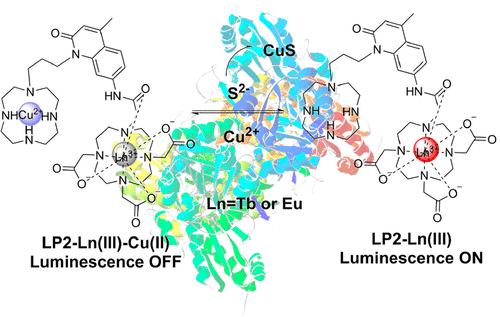当前位置:
X-MOL 学术
›
Inorg. Chem.
›
论文详情
Our official English website, www.x-mol.net, welcomes your
feedback! (Note: you will need to create a separate account there.)
Time-Gated Luminescence Detection of Enzymatically Produced Hydrogen Sulfide: Design, Synthesis, and Application of a Lanthanide-Based Probe
Inorganic Chemistry ( IF 4.3 ) Pub Date : 2017-12-27 00:00:00 , DOI: 10.1021/acs.inorgchem.7b02533 Yao Yao 1 , Loruhama Delgado-Rivera 2, 3 , Hamid Samareh Afsari 1 , Liang Yin 2, 3 , Gregory R. J. Thatcher 2, 3 , Terry W. Moore 2, 3 , Lawrence W. Miller 1
Inorganic Chemistry ( IF 4.3 ) Pub Date : 2017-12-27 00:00:00 , DOI: 10.1021/acs.inorgchem.7b02533 Yao Yao 1 , Loruhama Delgado-Rivera 2, 3 , Hamid Samareh Afsari 1 , Liang Yin 2, 3 , Gregory R. J. Thatcher 2, 3 , Terry W. Moore 2, 3 , Lawrence W. Miller 1
Affiliation

|
Hydrogen sulfide (H2S) is now recognized as an important gaseous transmitter that is involved in a variety of biological processes. Here, we report the design and synthesis of a luminescent lanthanide biosensor for H2S, LP2-Cu(II)-Ln(III), a heterobinuclear metal complex that uses Cu(II) decomplexation to control millisecond-scale-lifetime-Tb(III)- or Eu(III)-emission intensity. LP2-Cu(II)-Ln(III) responded rapidly, selectively, and with high sensitivity to aqueous H2S. The probe’s potential for biological applications was verified by measuring the H2S generated by the slow-releasing chemical-sulfide-donor GYY4147, by cystathionine γ-lyase (CSE), and by Na2S-stimulated HeLa cells.
中文翻译:

酶促产生的硫化氢的时间门控发光检测:基于镧系元素的探针的设计,合成和应用
如今,硫化氢(H 2 S)被认为是一种重要的气体传输剂,它参与了多种生物过程。在这里,我们报告为H 2 S,LP2-Cu(II)-Ln(III)(一种使用Cu(II)分解来控制毫秒级寿命-Tb的异双核金属配合物)的发光镧系元素生物传感器的设计和合成(III)或Eu(III)的发射强度。LP2-Cu(II)-Ln(III)对H 2 S水溶液具有快速,选择性和高灵敏度的响应。通过测量缓慢释放的化学硫化物产生的H 2 S可以验证该探针在生物学上的潜力。胱硫醚γ-裂合酶(CSE)和Na 2 S刺激的HeLa细胞作为供体GYY4147 。
更新日期:2017-12-27
中文翻译:

酶促产生的硫化氢的时间门控发光检测:基于镧系元素的探针的设计,合成和应用
如今,硫化氢(H 2 S)被认为是一种重要的气体传输剂,它参与了多种生物过程。在这里,我们报告为H 2 S,LP2-Cu(II)-Ln(III)(一种使用Cu(II)分解来控制毫秒级寿命-Tb的异双核金属配合物)的发光镧系元素生物传感器的设计和合成(III)或Eu(III)的发射强度。LP2-Cu(II)-Ln(III)对H 2 S水溶液具有快速,选择性和高灵敏度的响应。通过测量缓慢释放的化学硫化物产生的H 2 S可以验证该探针在生物学上的潜力。胱硫醚γ-裂合酶(CSE)和Na 2 S刺激的HeLa细胞作为供体GYY4147 。











































 京公网安备 11010802027423号
京公网安备 11010802027423号